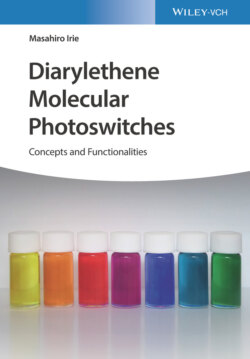Читать книгу Diarylethene Molecular Photoswitches - Masahiro Irie - Страница 18
2.3.2 Cycloreversion Reaction
ОглавлениеIn contrast to the cyclization reaction described in Section 2.3.1, it is difficult to directly measure the time constant of the ring‐opening (cycloreversion) reaction, because the absorption spectrum of the photogenerated open‐ring isomer and that of the closed‐ring isomer overlap in the UV region. The time constant was estimated from the decay of the transient absorption spectra as well as the fluorescence signal of the closed‐ring isomer.
Figure 2.12 shows time‐resolved transient absorption spectra of the closed‐ring isomer of 1,2‐bis(2‐methyl‐5‐phenyl‐3‐thienyl)perfluorocyclopentene (20c) in a n‐hexane solution excited with a femtosecond laser pulse at 600 nm [12]. Time evolution of the spectra following the excitation can be divided into three stages. In the time region immediately after the excitation (0–0.5 ps), the absorption at 860 nm appears together with the negative signal due to the bleaching of the steady‐state absorption at around 600 nm. In the initial 0.5‐ps time range, the intensity of the absorption at 860 nm slightly decreases and that at 890 nm relatively increases, together with the appearance of the absorption around 700 nm. The absorption at 860 nm is due to the initially formed 1B state, while the subsequently growing bands at 890 and 700 nm are attributable to the 2A state. In the following second stage at the time region of 0.5–5 ps, the relative ratio of the transient absorption at 890 and 700 nm to that at 860 nm gradually increases. Finally, after 5 ps following the excitation, the decay of the positive and negative absorption intensities to the baseline was observed with no remarkable evolution of the spectral band shape.
Figure 2.12 Time‐resolved transient absorption spectra of 20c in n‐hexane excited with a 600 nm femtosecond laser pulse.
Source: Reprinted with permission from Ref. [12]. Copyright 2017 American Chemical Society.
The time profiles of the transient absorbance monitored at 840 and 700 nm are reproduced by a triple exponential function with time constants of 200 fs, 3.0 ps, and 12 ps. As shown in Figures 2.7 and 2.8, the 1BFC(c) state produced by photoexcitation of the closed‐ring isomer 20c undergoes the internal conversion to the local minimum of 2A state (2Ac) via 1B/2A CI(c). The 2Ac state goes over the energy barrier, 2ATS1, in competition with the direct non‐radiative as well as radiative decay processes to the ground state. According to this mechanism, the shortest time constant of 200 fs is attributed to the internal conversion from the 1B state to the 2Ac state. The bands at 890 and 700 nm are ascribable to the 2Ac state, because the rise of these bands is accompanied by the decay of the band at 860 nm assigned to 1B state. To elucidate the origin of the second 3‐ps component, the time profile of the transient absorbance at 700 nm divided by that at 840 nm was plotted. The relative intensity rapidly increased within 1 ps and was followed by the gradual increase in several picosecond time region. This time profile indicates that the rapid internal conversion yields the 2Ac state with the time constant of 200 fs and the slow 3‐ps process leads to the spectral evolution in the 2Ac state. The time constant of 3.0 ps is attributed to the geometrical rearrangement in the excited state, because 3 ps is in the typical temporal scale of vibrational cooling in solution. Finally, the longest time constant of 12 ps is ascribable to the lifetime of the 2Ac state, because the recovery of the transient bleaching of the ground state and the decay of the positive transient absorption have the same time constant of 12 ps. Temperature dependence of the transient absorption decay and the fluorescence decay at 700 nm was measured and it was found that both transient absorption and fluorescence decay constants become longer with decrease in the temperature. The time constant of the transient absorption decay was almost identical to the fluorescence lifetime. The agreement of these two time constants indicates that the 2Ac state gives the fluorescence. The 2Ac state goes over the energy barrier (2ATS1) with a time constant of 12 ps at room temperature and finally leads to the photoproduct via 2A/1ACI(o). Both cyclization and cycloreversion reactions take place via the common CI(o). The cyclization reaction in solution completes within 1 ps, as described before. Therefore, the staying time in the 2Ao state is considered to be less than 1 ps. The time constant of 12 ps reflects the time taken to overcome the barrier 2ATS1.
Inferring from the experimental results, the cycloreversion dynamics of 20c is summarized as follows. The 1B state produced by the excitation of the closed‐ring isomer undergoes internal conversion into the 2Ac state with the time constant of 200 fs, which is followed by geometrical rearrangement with vibrational cooling in 3.0 ps. The resultant 2Ac state goes over the activation barrier (2ATS1) into the 2Ao state with the time constant of 12 ps and finally leads to the open‐ring isomer via the 2A/1ACI(o).
